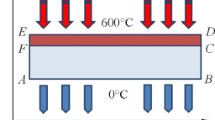Abstract
Measurement data on unsteady temperature fields in decomposing thermoprotective coatings and on mass losses in a high‐temperature inert‐gas (nitrogen) flow are reported. With the use of analytical and numerical methods for solving boundary and coefficient inverse heat‐ and mass‐transfer problems, thermophysical and kinetic characteristics of thermoprotective materials made by two modifications of chlorosulfonated polyethylene and powdered polypropylene filler are found.
Similar content being viewed by others
REFERENCES
O. M., Alifanov, Inverse Heat–Transfer Problems [in Russian], Mashinostroenie, Moscow (1988).
G. N. Isakov, A. Ya. Kuzin, “Determination of thermophysical characteristics of porous materials,” in: Heat Transfer and Thermophysical Properties of Porous Materials, Proc. of All–Union Seminar, Institute of Thermal Physics, Novosibirsk (1992), pp. 235–241.
G. N. Isakov, Heat–and Mass–Transfer, and Ignition in Heterogeneous Systems [in Russian], Russian Acad. of Sci., Sib. Div., Novosibirsk (1999).
A. V. Lykov, Theory of Thermal Conductivity [in Russian], Vysshaya Shkola, Moscow (1967).
A. F. Chudnovskii, Thermophysical Characteristics of Dispersed Materials [in Russian], Gos. Izd. Fiz.–Mat. Lit., Moscow (1962).
A. M. Grishin, A. Ya. Kuzin, V. L. Mikov, et al., Solution of Some Inverse Problems in the Mechanics of Reacting Media [in Russian], Izd. Tomsk. Univ., Tomsk (1987).
G. N. Isakov, “Macrokinetics of thermal and thermooxidative destruction of organic–reinforced plastic on heating in a gas flow,” Combust. Expl. Shock Waves, 30, No. 3, 311–315 (1994).
G. N. Isakov, V. V. Nesmelov, et al., “On the theory of relaxation processes in decomposing polymer materials under highly intense convective heating,” Dokl. Akad. Nauk SSSR, 278, No. 5, 1112–1115 (1984).
V. I. Zinchenko, V. V. Nesmelov, A. S. Yakimov, and G. F. Kostin, “Effect of variation of the physicochemical properties of a phenolic carbon plastic on nonstationary heat and mass exchange in high–temperature destruction in a gas flow,” Combust. Expl. Shock Waves, 33, No. 5, 576–582 (1997).
O. F. Shlenskii, A. G. Shashkov, and L. N. Aksenov, Thermophysics of Decomposing Materials [in Russian], Energoatomizdat, Moscow (1985).
O. M. Alifanov, E. A. Artyukhin, and S. V. Rumyantsev, Extremal Methods for Solving Ill–Posed Problems [in Russian], Nauka, Moscow (1988).
N. V. Muzylev, “Uniqueness of simultaneous determination of thermal conductivity and volume heat capacity,” Zh. Vychisl. Mat. Mat. Fiz., 23, No. 1, 102–108 (1983).
M. V. Klibanov, “Uniqueness theorem for one class of coefficient inverse problems,” Inzh.–Fiz. Zh., 49, No. 6. 1006–1009 (1985).
A. M. Grishin and S. P. Sinitsyn, “Theory of the pyrolysis of composite polymer materials,” Combust. Expl. Shock Waves, 20, No. 6, 654–664 (1984).
V. M. Yudin, “Heat and mass transfer in fiberglass plastics,” Inzh.–Fiz. Zh., 24, No. 4, 618–626 (1973).
E. Jahnke, F. Emde, and Lösh, Tafeln Hhërer Funktionen, Teubuer, Stuttgart (1959).
Yu. P. Adler, E. V. Markova, and Yu. V. Granovskii, Experiment Planning for Finding Optimum Conditions [in Russian], Nauka, Moscow (1976).
V. V. Pikalov and N. G. Preobrazhenskii, “Abel transformation in the interferometic holography point explosion,” Combust. Expl. Shock Waves, 10, No. 6, 827–833 (1974).
Yu. E. Voskoboinikov, “Abel equation inversion using cubic splines,” in: Abel Inversion and Its Generalization (collected scientific papers) [in Russian], Inst. Theor. Appl. Mech., Sib. Div., Acad. of Sci. of the USSR, Novosibirsk (1978), pp. 180–189.
V. V. Nesmelov, V. D. Gol'din, V. N. Savel'ev, and V. F. Ermolaev, “Experimental study of special characteristics of TTPS thin–layer thermoprotective coatings in a plasma flow,” in: Rocket and Space Engineering (collected scientific papers) [in Russian], Ser. 12, Issue 2(47), Miass (2001), pp. 3–18.
V. L. Strakhov, S. I. Leonova, and A. M. Garashchenko, “Some results on temperature–dependent thermophysical characteristics of composite polymers,” Inzh.–Fiz. Zh., 33, No. 6, 1047–1051 (1977).
A. A. Samarskii, Theory of Difference Schemes [in Russian], Nauka, Moscow(1983).
Yu. S. Zav'yalov, B. I. Kvasov, and V. L. Miroshnichenko, Spline–Function Methods [in Russian], Nauka, Moscow (1980).
N. B. Vargaftik, Thermophysical Properties of Gases and Liquids: Handbook [in Russian], Nauka, Moscow (1972).
Author information
Authors and Affiliations
Rights and permissions
About this article
Cite this article
Isakov, G.N., Kuzin, A.Y., Savel'ev, V.N. et al. Determination of Characteristics of Thin‐Layer Thermoprotective Coatings by Solving Inverse Heat‐ and Mass‐Transfer Problems. Combustion, Explosion, and Shock Waves 39, 563–573 (2003). https://doi.org/10.1023/A:1026165919610
Issue Date:
DOI: https://doi.org/10.1023/A:1026165919610




